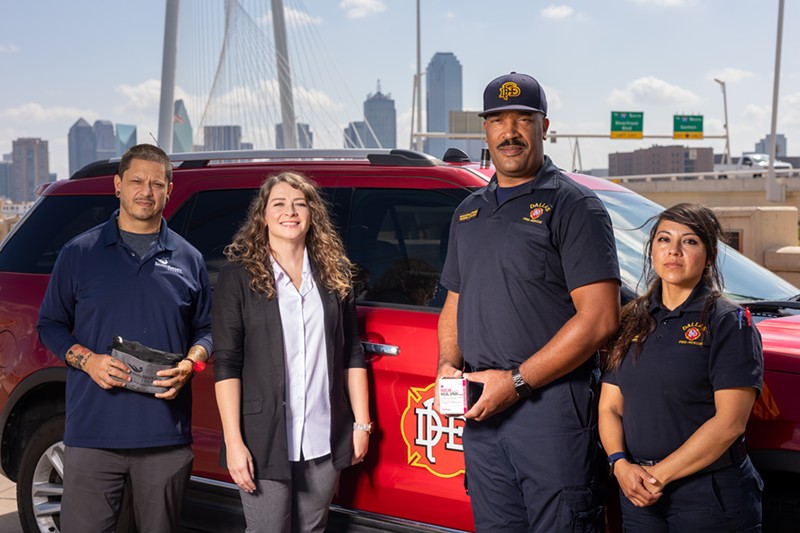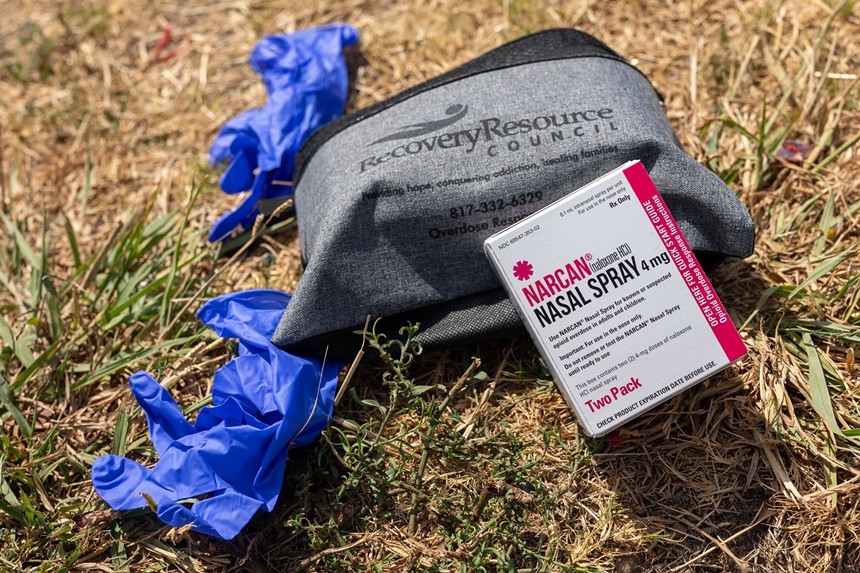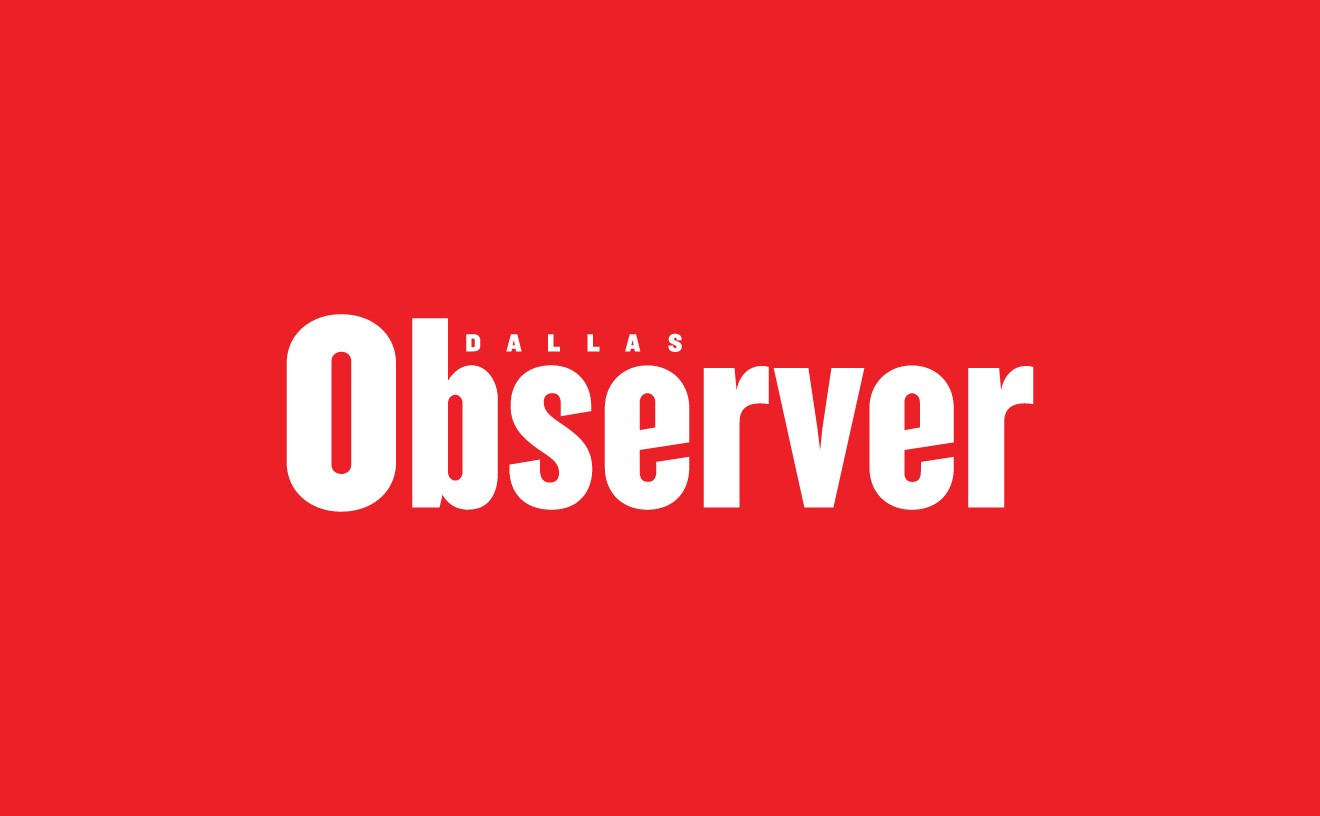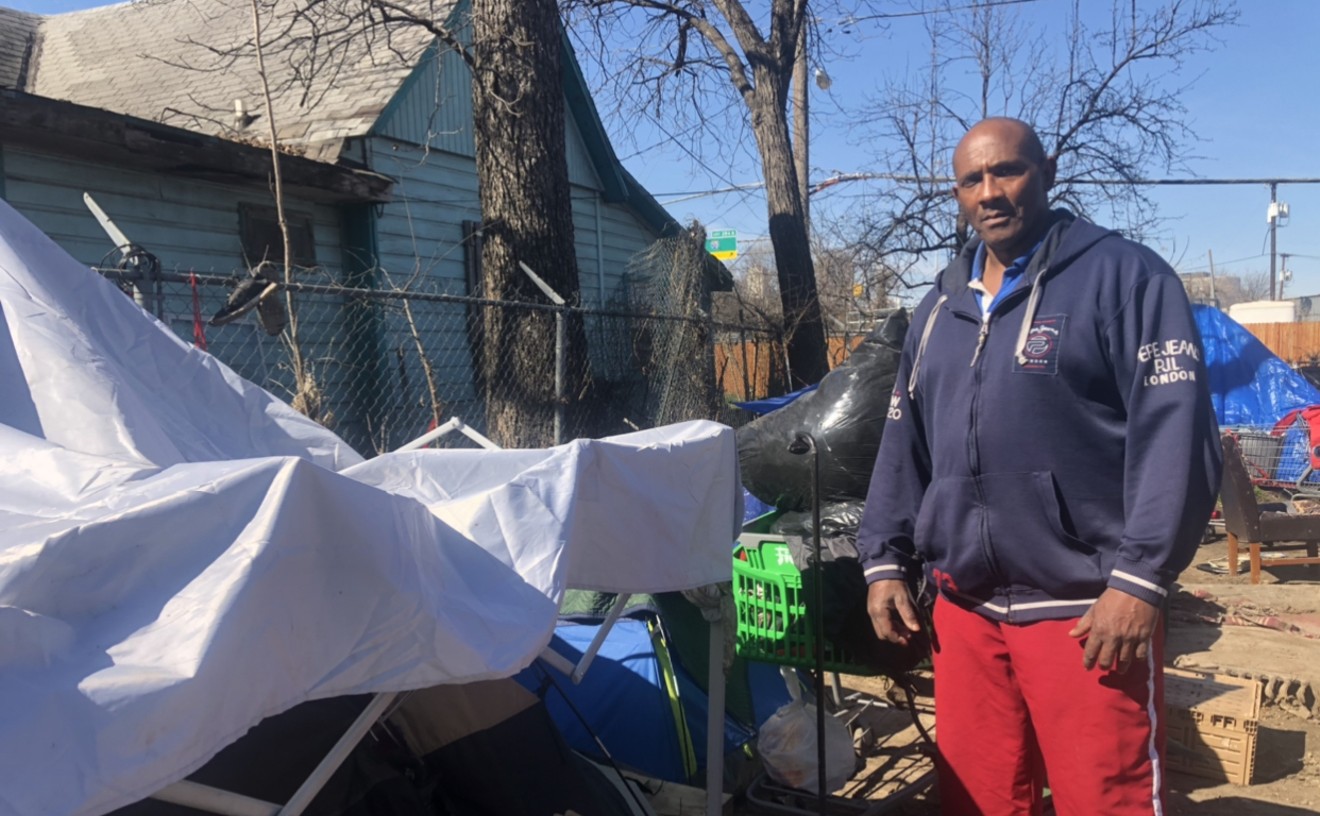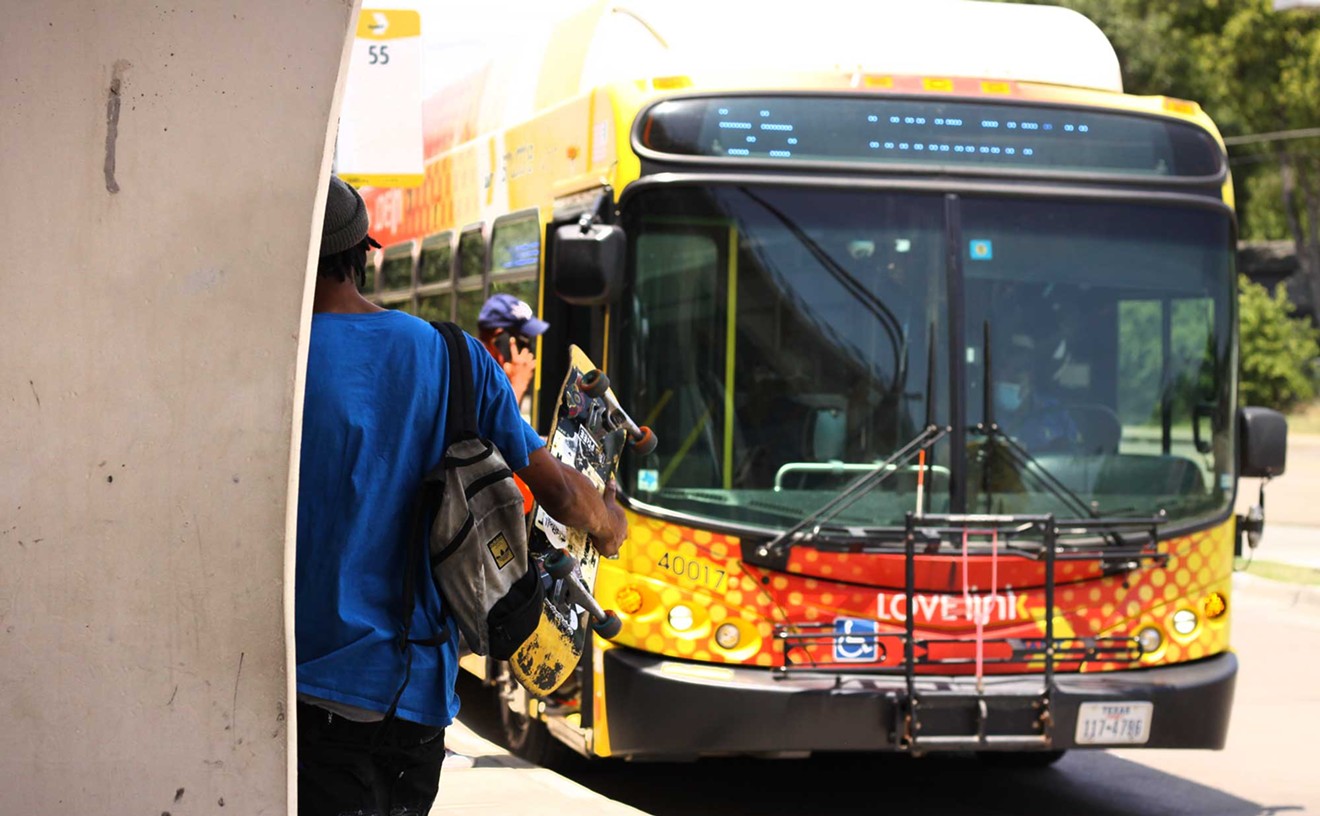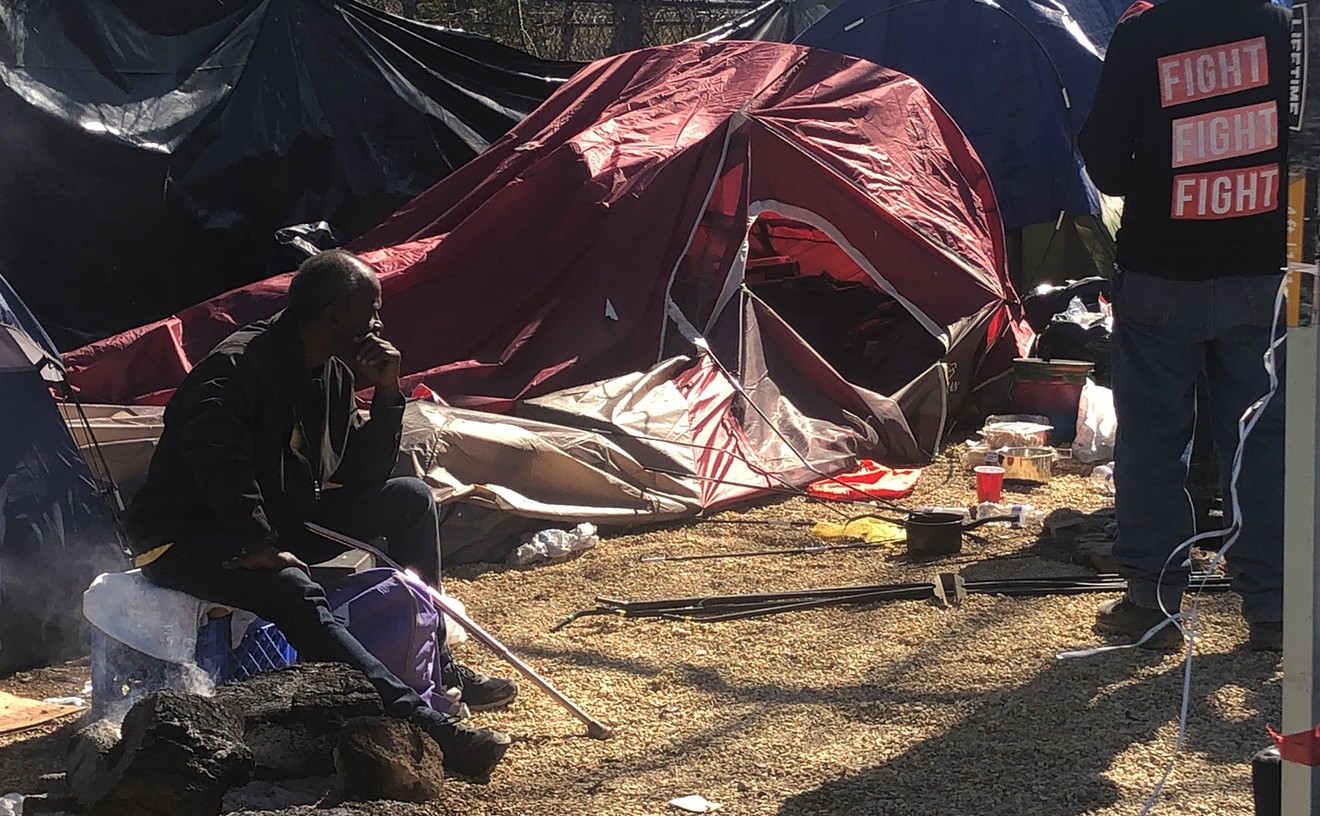If all goes as intended, the patient will regain consciousness in 2–3 minutes. But it will feel like a lifetime before the first responders know whether the Narcan successfully blocked the effects of the opioid on the brain, enabling normal breathing to resume. The patient’s life depends on this specific dosage working and working as quickly as possible. Should the spray not have the intended effect, another dose will be administered.
The specifics from incident to incident vary, of course. More and more, this harrowing scenario is taking place in surprising places such as suburban teen bedrooms and junior high school classrooms. In one way or another, this chilling sequence has played out in Dallas at an alarmingly increasing rate over the past few years, and in 2023 more than ever before.
Through the end of July this year, Dallas Fire-Rescue paramedics had administered 1,469 doses of Narcan to suspected opioid overdose victims. That’s an average of seven per day; should that pace continue until the end of the year, 2023’s total will dwarf the roughly 2,000 doses administered last year and the 1,200 in 2021.
For Dallas’ Opioid Response Team (ORT), the thousands of distressing rescues carried out by paramedics is only the first act in a drama undertaken by the young life-saving organization, whose purpose is to find those spared by Narcan and get them into long-term treatment for drug abuse.
"After introductions and explaining why we were there, he immediately expressed that he was ready and willing to do whatever he needed to do to get help.” – Opioid Response Team peer specialist
tweet this
A local government partnering on a progressive, new approach to a rising problem sounds great in theory. It is in reality as well, of course, but real life rarely plays out as smoothly as it does in a City Council presentation. Success hinges on whether the person the specialists attempt to reach can even be found. It isn’t uncommon for the peer specialist and a DFR paramedic to make multiple attempts before either finally making contact with the client or deciding the well of opportunity had run dry in that case.
One Recovery Resource Council peer specialist, who asked to remain anonymous because of the nature of the work, said they made contact with a recent client they helped into a treatment program only after their third attempt to contact him personally. To be clear, it was not the third try to speak with the client in the days immediately following an overdose: The successful contact came following the third separate overdose the client had suffered.
“The previous two times that engagement was attempted,” the peer specialist said, “[the client] was in the hospital (once in ICU), so we were unable to engage him in any follow-up services. On the third attempt, he was sitting outside when we approached the residence. After introductions and explaining why we were there, he immediately expressed that he was ready and willing to do whatever he needed to do to get help.”
The next day the peer specialist returned to help the client navigate treatment options in the area that he could begin right away. The client got emotional as he explained that he had been using drugs for over 50 years and this would be his first real attempt at sobriety. He was surprised at how fast the peer specialist was working, but was ready for a new start after his latest overdose two days earlier.
If that sounds (almost) too simple and straightforward, that’s because it is. The peer specialist confirmed availability with one local facility, which sent an Uber to pick up the client that afternoon. But a couple of hours later, the client called the peer specialist in a panic. The facility didn’t have a bed for him after all, and he was scared to go back home now that he had made the decision to get help. Frantically, the peer specialist reached out to colleagues, who helped find a suitable alternative that day.
According to the peer specialist, that client is still working through the treatment program. It’s safe to say he likely wouldn't have known about or had access to the program without the opioid response team helping him to understand his options and to navigate the barriers to receiving the treatment. That knowledge, combined with the unique perspective peer specialists provide, can be a powerful combination for people who need help the most to finally get it.
Michael Watkins is one of the peer specialists at Recovery Resource Council. He’s been in abstinence-based recovery since getting sober in 2012. That lived experience as an addict is both essential to becoming a peer specialist and invaluable in genuinely connecting with prospective clients.
“My experience is the ally that I use,” Watkins said. “When I was out there doing what I was doing, I didn't want to stop and I always thought I would figure it out at some point. I had to get broken down to a point where I was finally like, ‘You know what? I don't want this anymore, but I don't know what else to do.’ The people who really helped me came to me when I ended up at the hospital, and they said they were there to help me and tell me what I needed to do if I was serious about it.”
Certainly an understanding of what has worked for him through more than a decade of recovery is useful to Watkins and other peer specialists aiming to help overdose patients find their way to help. But that background doesn't mean all scenarios they enter are the same, nor does it mean that knocking on the door of someone who overdosed on opioids a day or two before will ever yield predictable results.
“You really never know what to expect, so I just always try to be myself,” he said. “In many cases, these people aren’t used to people like us knocking on their doors. My hope is that I can say, ‘Look, this is my experience, and this is how I can help. I’m not here to make you do anything you don’t want to do or to do anything the same way I did it.’”
***
On the surface, it might be hard to tell just how successful the ORT has been so far. Of the nearly 1,500 overdoses treated by Dallas Fire-Rescue so far in 2023, the ORT, which did not begin its partnership with the city until late January, has assisted just over 60 overdose patients by providing harm reduction supplies such as Narcan and resources they could use to contact the ORT directly should they be ready to proceed into recovery further. Of that number, 20 have been connected to follow-up services for treatment and recovery. Clearly, those numbers mean the overwhelming majority of overdoses treated by DFR in 2023 have not had the help of the ORT for one reason or another. But it also means that in just a few months, dozens of people who have been in drug-related danger in Dallas now have at least an understanding of what sort of help is available to them that they were unaware of before, or they are finally getting the assistance they need. That’s a lot of brightened futures.
There are also logical reasons for the disparity. DFR conducts a screening process each time paramedics administer Narcan, and not every one of those patients are submitted for ORT follow-up. In addition, the locations given to ORT come from 911 data, which means it’s where paramedics treated the overdose. Often, it’s not the home address of the person being sought.
Then there are the people who slam the door or refuse to answer the door for the ORT, and it’s easy to understand the gap between 911 calls for opioid overdoses and new clients who have been assisted in some way by the ORT.
"My hope is that I can say, ‘Look, this is my experience, and this is how I can help." – Michael Watkins, Recovery Resource Council
tweet this
Regardless, the positive impact is large but hard to truly quantify. Tell those who were likely moments away from dying only a few days earlier, or tell their family and friends, that since they were one of only a small percentage of Dallas overdoses to receive help it's anything but a triumph.
Just before the ORT began operating, DFR Battalion Chief Scott Clumpner, who oversees the DFR side of the program, told the Observer that going beyond simply administering Narcan to overdose patients represented a desire to “get out ahead of” the problem. But he also noted it did not necessarily represent a change to any of his staff’s overall goal.
“The goal of this program is to prevent death,” Clumpner said.
***
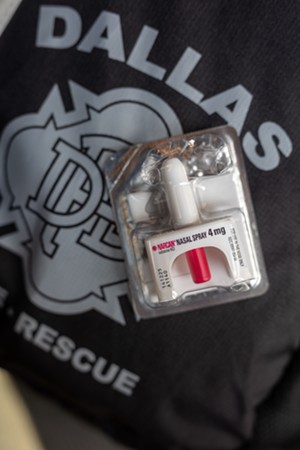
A close-up of Narcan nasal spray used for reversing the effects of an opioid overdose.
Nathan Hunsinger
“We’re meeting our clients where they are,” she said. “So that sometimes means we’ll meet them in a place where harm reduction is needed because it’s keeping them alive with the hope that the day will come when they do want to talk about next steps with us.”
Watkins points to the troubling and drastic rise of fentanyl use as a key reason harm reduction practices are perhaps more important than ever before. Cheaper and more powerful than other opioids, fentanyl can affect opioid addicts in ways that can’t be overlooked.
“If fentanyl had been around when I was in my early 20s, I guarantee I wouldn't be here right now,” Watkins said. “So, Narcan serves even more of a purpose now. Fentanyl presents a more immediate harm than ever before, and there’s a lot of people that don't understand and think Narcan is just going to let users use more. I’m like, ‘No, it’s going to save lives.’”
“We approach every single client with a guarantee of unconditional acceptance and respect.” – Becky Tinney, Recovery Resource Council
tweet this
The ORT sometimes comes into contact with a family member or someone else who might be living at the same address as the overdose patient they’re trying to meet. Tinney says it can be just as helpful, if not more so, to ensure those people are educated on how to administer Narcan and the signs to watch for if they suspect someone close to them is experiencing an overdose.
It’s not uncommon for those related to an opioid addict to feel helpless. The ORT recently encountered some parents who had felt helpless as they watched paramedics administer eight doses of Narcan to their college-aged daughter in their home just a day earlier. The daughter was revived by the medicine after her father had tried to help her using CPR before the paramedics had arrived. The ORT members found the young client ready to make a change after years of opioid abuse. She wasn't quite ready to enter treatment immediately, but she was ready to talk more about it moving forward. As the peer specialist left the house, the mother leaned in and said, “Please save my daughter.”
As crucial as the moment a paramedic helps revive an opioid overdose victim is, it’s the mission of the peer specialists and paramedics of the opioid response team to see beyond that life-and-death moment. The user, once they are picked up off the sidewalk or helped off a bedroom floor, has to take another step, wake up for another day and, perhaps, one day live a healthy life. The ORT’s goal is to help them do those things.
“We approach every single client with a guarantee of unconditional acceptance and respect,” Tinney said. “At the end of the day, they’re a human being, they’re somebody’s mother, father, child, or sibling. Somebody cares about that person. We encounter individuals that have lost that sense of self-value. They’ve lost that because of the struggles they’ve been through and the trauma they’ve experienced. It’s really important for us to help them reestablish that and let them know we value their life.”

